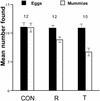Facultative bacterial symbionts in aphids confer resistance to parasitic wasps
- PMID: 12563031
- PMCID: PMC149914
- DOI: 10.1073/pnas.0335320100
Facultative bacterial symbionts in aphids confer resistance to parasitic wasps
Abstract
Symbiotic relationships between animals and microorganisms are common in nature, yet the factors controlling the abundance and distributions of symbionts are mostly unknown. Aphids have an obligate association with the bacterium Buchnera aphidicola (the primary symbiont) that has been shown to contribute directly to aphid fitness. In addition, aphids sometimes harbor other vertically transmitted bacteria (secondary symbionts), for which few benefits of infection have been previously documented. We carried out experiments to determine the consequences of these facultative symbioses in Acyrthosiphon pisum (the pea aphid) for vulnerability of the aphid host to a hymenopteran parasitoid, Aphidius ervi, a major natural enemy in field populations. Our results show that, in a controlled genetic background, infection confers resistance to parasitoid attack by causing high mortality of developing parasitoid larvae. Compared with uninfected controls, experimentally infected aphids were as likely to be attacked by ovipositing parasitoids but less likely to support parasitoid development. This strong interaction between a symbiotic bacterium and a host natural enemy provides a mechanism for the persistence and spread of symbiotic bacteria.
Figures



References
Publication types
MeSH terms
Substances
LinkOut - more resources
Full Text Sources

